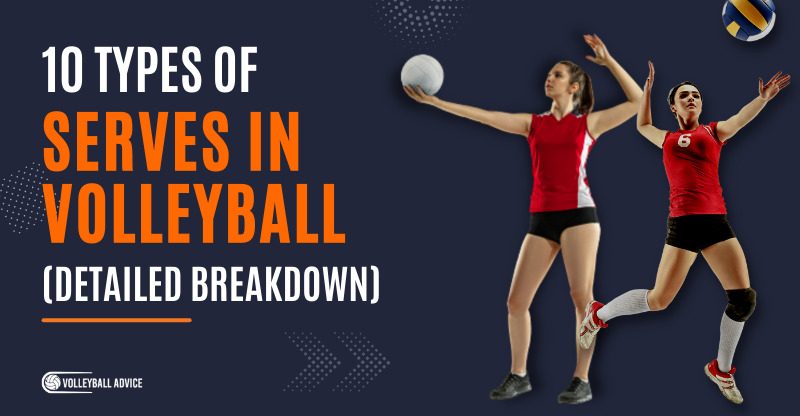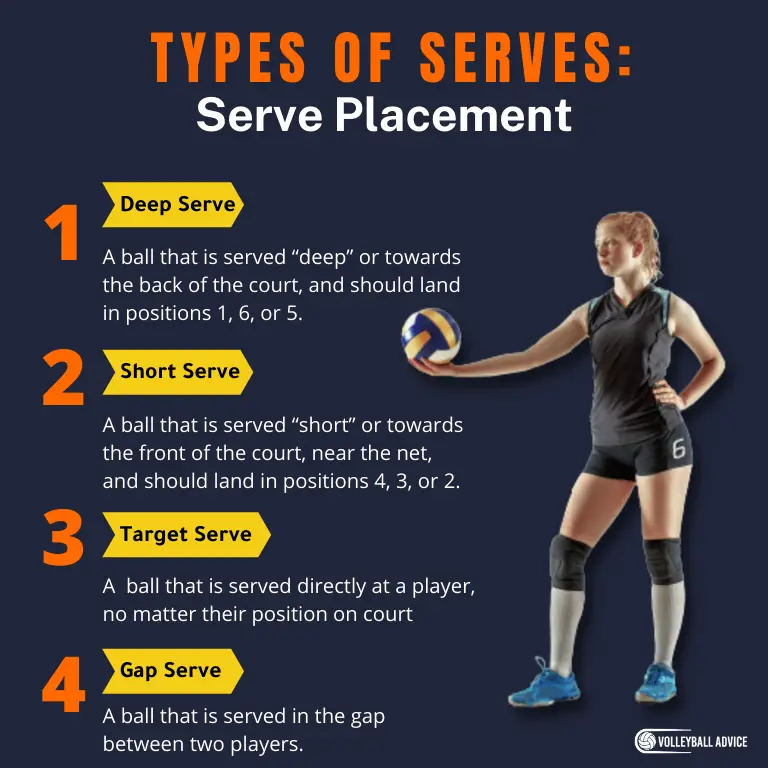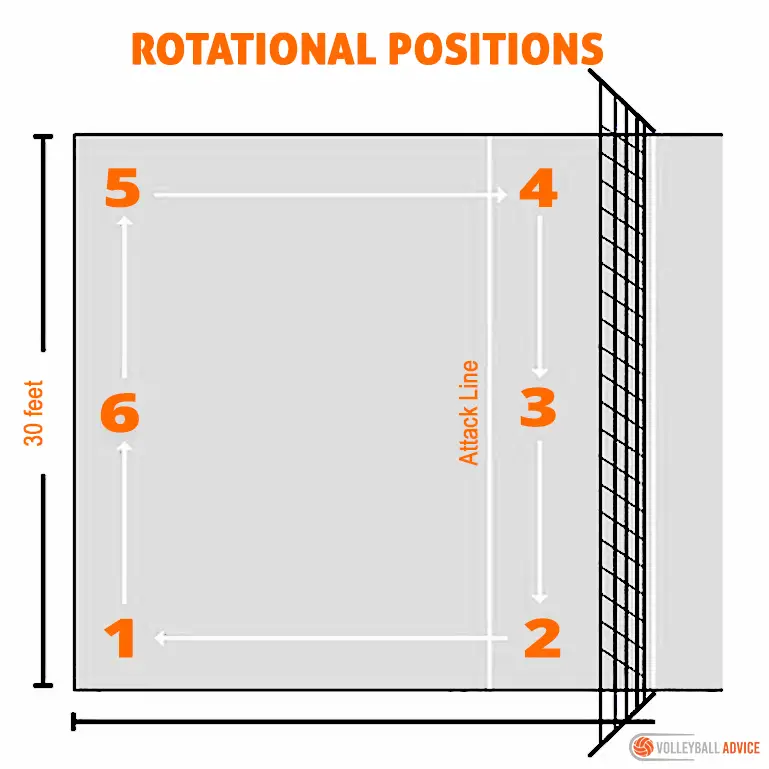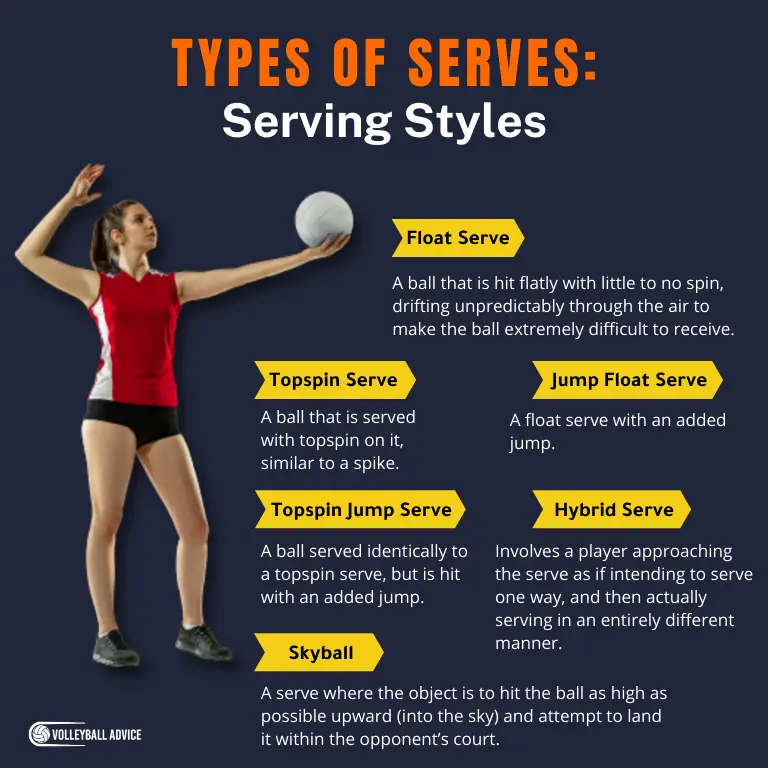10 Types of Serves In Volleyball (Detailed Breakdown)
Serving provides you a powerful opportunity to score by yourself – either by acing the other team or serving up an unreturnable ball. A good server has the ability to swing defeat towards victory.
Ivan Zaytsev of Italy’s performance in the 2014 World League Finals is perhaps the most famous and lasting example of this where he scored 4 aces in a row against Team USA to close out the game in an epic comeback.
Knowing your serving options and choosing between the different types can help reduce nervousness, and picking the right serve for the right situation will yield better results than recycling the same exact serve over and over again.
So, what are the different types of serving in volleyball? Serving in volleyball is defined as either underhand or overhand, and is further organized into either serve placement (such as serving deep or short) and serving style (float vs topspin). Within these categories are ten types: deep, short, target, gap, float, topspin, topspin jump, jump float, hybrid, and skyball.
Most players will only incorporate a simple float serve into their serving routine, and while this is perfectly acceptable, it could be better.
Today, I’m going to break down the different types of serving and give you the inside edge on how to win the solo game of serving. By the end of this article, you should be able to:
- Identify the different types of serving
- Know how to use them
- Understand in what situations each should be used
Serving In Volleyball: What Are The Components?
Regardless of the type of serve, a good serve should combine proper technique with a good toss.
To quickly review:
- Stance: Your stance should be reminiscent of spiking technique with a high elbow, standing slightly angled to the ball.
- Contact: A float serve should seek to contact the ball as flat as possible with little spin, while a topspin serve relies on technique to generate the spin which gives it control and accuracy.
- Tossing: Toss the ball in front of you, allowing yourself to move through the ball and into court. A toss for float serves should be lower than topspin serves. Hit just below the apex of your swing in order to maintain the low-to-high motion needed to get the ball over the net. Everyone has a different sweet spot, so practice different tosses until you find your own.
If you haven’t already, establish a routine. This can be anything from bouncing the ball a certain number of times to picturing something mentally; it doesn’t have to be obvious, it just has to work for you.
A routine provides an unconscious link between serving in practice and serving in matches, and will help you perform consistently under pressure. Be sure to incorporate your routine and serve seriously during practice, otherwise when you do it in matches you’ll revert to your practice form.
Underhand vs Overhand Serving
Underhanded serves are the primary way children are taught to serve because it reinforces the notion of “low to high”. This makes it easier to get the ball over the net and into play, but sacrifices power among other things to do this.
Overhand serves are the standard way of serving in competitive volleyball. This involves hitting from a hitting frame position, similar to spiking. While topspin serves maintain the spiking frame throughout the serve, float serves contact the ball flatly without any body torque and look very different.
For casual play or anyone just starting out, underhanded serves work perfectly well and can even achieve surprising amounts of accuracy. For anyone looking to enter competitive play, however, overhand serving is a necessity.
Types of Serves: Serve Placement
Serve placement is all about where you hit the ball on court.
As in other sports, “deep” refers to farther back on court towards the back, while “short” refers to areas towards the middle, near the net. To be even more specific in volleyball, and to know exactly where on court we are talking about, we refer to areas as “positions”.
Although the different roles of players are also referred to as “positions”, in this section I will be referring to positions in their other context as the different numbered zones on court.
These are shown in the image below as “Rotational Positions”:
Use this to refer to positions as we discuss serving in this section.
The four types we’ll be covering here are:
- Deep Serve
- Short Serve
- Target Serve
- Gap Serve
Type #1: Deep Serve
A deep serve is a ball that is served “deep” or towards the back of the court, and should land in positions 1, 6, or 5.
This kind of serve is used to put the defenders on the back foot and away from the net, prompting a farther pass which in turn makes the set more challenging. This is the most common type of serve, and mixing it with one of the serving styles from the next section makes it an excellent choice.
To perform this, either in float or topspin, you will need to give the ball a bit of extra power. Aim for the ball to land within the last meter of the court if possible, and avoid hitting it to the middle of the court where it will be easily passed, wasting your serve and putting your team at a disadvantage as they prepare for the spike.
Type #2: Short Serve
A short serve is a ball that is served “short” or towards the front of the court, near the net, and should land in positions 4, 3, or 2.
As the exact opposite of the deep serve, the short serve seeks to put the setter and hitters at a disadvantage by making them scramble to the net and taking away their agency to hit. This type of serve is best used when the setter is back court and needs to transition to the net as fast as possible, putting him at a disadvantage.
To perform this, take a bit of the power off of your serve and arc it slightly more than usual. If you’re still struggling, try serving diagonally across the court, such as standing behind position 1 and serving short to position 4. This will let you retain some power while still performing a short serve.
Type #3: Target Serve
A target serve is a ball that is served directly at a player, no matter their position on court.
This kind of serve is incredibly annoying to play against, and attempts to target a specific player who is a weak passer in order to limit the opposing team’s options.
This strategy can result in free points for your team as the targeted player shanks balls out of bounds and gives poor passes to the setter, but can be easily countered by a smart team by repositioning their defense to “hide” the player and take the pass for them.
When this happens, consider your job done and either aim at a different player or move on to a different serve placement.
Type #4: Gap Serve
A gap serve is a ball that is served in the gap between two players.
This serve is infamous for giving free points to the server even at very high levels of play, and even Olympic level teams have missed points because of this serve and miscommunication.
Typically, this serve is directed between positions 1 and 6, or 6 and 5. If the players don’t communicate early or confidently take the ball, it will pass between both of them and result in a point for you. A simple strategy but timeless all the same.
If in doubt, use this serve.
Check out this guide: Hand Positions for Volleyball Serving (3 Types)
Types of Serves: Serving Styles
This section covers how a player contacts the ball, resulting in a certain kind of “serving style”.
The six types of serving styles are:
- Float Serve
- Topspin Serve
- Topspin Jump Serve
- Float Jump Serve
- Hybrid Serve
- Skyball
Type #5: Float Serve
A float serve is a ball that is hit flatly with little to no spin, drifting unpredictably through the air to make the ball extremely difficult to receive.
The preferred serve of many coaches, float serves are tough to receive and relatively easy to learn, combining a good amount of safety with a touch of challenge. If you haven’t learned this style already, odds are you will very soon.
To perform a float serve, toss the ball with as little spin as possible and keep your hand flat as you hit. The goal should be to generate absolutely no spin, as a “quiet” (unspinning) ball drifts far more than a spinning one.
An old volleyball trick to controlling where the ball floats is to position the air valve on the opposite side of where you want it to go. Doing this and hitting the ball slightly off-center in the opposite direction of the desired Point of Impact (POI) will cause the ball to move and dance through the air, earning you a point more often than you think.
Type #6: Topspin Serve
A topspin serve is a ball that is served with topspin on it, similar to a spike.
Topspin serves are fast serves that are a natural tool of already good spikers. Think of the serve as hitting a “downball” spike from the back row (positions 1, 6, and 5): you need to angle it a bit higher and give it a bit more juice, but it’s the same concept.
These serves are good for safety and accuracy. They offer the lowest possibility of scoring an ace, however, and rarely pose any real threat to the opposite team. Still a good tool to have, but this should never be a server’s first choice.
Type #7: Topspin Jump Serve
A topspin jump serve is a ball served identically to a topspin serve, but is hit with an added jump.
What a difference jumping can make. Adding a bit of height and momentum turns the underwhelming topspin serve into an absolute monstrous weapon that is far and away one of the most powerful tools in the game.
Essentially an unblockable spike from the baseline over the net, it is fast and hard to receive, sometimes described as a “heavy serve”. This kind of serve generates a “shock factor” from the sound of the hit and the feeling of the receive – stinging far more than a normal serve due to its power – and has the effect of hyping up your team while demoralizing the opposition.
The downside to this is that it is a difficult serve to execute and harder to master. Serving out of bounds, in the net, or missing the ball entirely will be common occurrences until a player becomes accustomed to the movement.
Additionally, this serve is fairly easy to receive by any team with experienced passers. All they need to do is step in the way with a proper platform, and suddenly your killer serve feels useless.
When this happens, mix your serving up and keep the other team on their toes – do not gift them points out of frustration.
If you’re looking to master this serve, practice often and with intent, and sink as many hours into serving as possible. Book a court and practice serving at least three times a week, whether at practice or alone. Be patient and you will see progress.
Type #8: Jump Float Serve
A jump float is a float serve with an added jump.
The advantage to this kind of serve is that it allows the player to hit the ball flatter without needing to hit the ball upwards as much or at all – allowing the ball to drop more radically and drift with more pace. This will cause the serve to float more aggressively, leading to more points for you and your team.
Compared to the other jump serve, the jump float has very few downsides and does not have one simple way to receive it. A deadly option for any server to use, its main challenge comes from the new footwork needed to jump.
With practice and patience, this should become a mainstay of most players’ arsenals.
Type #9: Hybrid Serve
Also known as the “feint serve”, a hybrid serve involves a player approaching the serve as if intending to serve one way, and then actually serving in an entirely different manner. This is used to fool the defense and surprise perceptive teams to gain the element of surprise.
The best way to practice this serve is to first practice both the float serve and topspin serve. Once you have done this and can use either comfortably, experiment with hitting each from the same exact toss. This will hide your intention until the moment of contact and provide you with a powerful weapon to use in matches.
A famous example of this is Polish National Team player Mateusz Bieniek who uses an untraditional hybrid serve to great effect. He won a gold medal at the 2018 FIVB World Championship and has represented his nation at many other international events. To see his serve in action, check out this clip against the US Men’s National Team.
Type #10: Skyball
A skyball is a serve where the object is to hit the ball as high as possible upward (into the sky) and attempt to land it within the opponent’s court.
This kind of serve is used almost exclusively in beach volleyball, since the ceilings of gyms and athletic centers do not allow the kind of height necessary to pull this serve off.
The extreme height and velocity cause the ball to drift, and any wind factors that exist on the beach move the ball even more radically, creating the most unpredictable and hard to receive ball in volleyball.
This serve is extremely risky to perform, however, and results in the ball landing out of bounds more often than not, giving away a free point. This is because it relies too heavily on unpredictable factors such as the weather and wind.
It is a fun serve to practice with friends, but even if you dedicate a large amount of time to learning it, chances are it will cost you more trouble than it’s worth.
That said, there’s nothing quite as funny as waiting ten seconds after someone has served to actually be able to play, and the way the opposing team has to scramble from one side of the court to the other as the ball drops gives many players a sense of glee. Try it out, have fun, but don’t say I didn’t warn you!
Final Thoughts
My challenge to you is to choose two types of serves in this article that you haven’t learned or haven’t mastered and practice them over the next week. Stay mindful of where you are hitting and why, and you’ll be an ace server in no time.
Other Useful Resources
- 4 Invaluable Tips To Serve Better
- Footwork for Serving a Volleyball: Technique, Drills, Errors
- Practicing Volleyball Serving Without A Net (Drills & Tips)
- 7 Types of Passing In Volleyball (Detailed Breakdown)
- 16 Types of Spiking In Volleyball (Detailed Breakdown)
- Types of Sets In Volleyball: 18 Types Explained
- How To Dive In Volleyball For Beginners (Step-by-Step Guide)
About The Author
Ailan Samuel is a writer and athlete who has played volleyball at the university, club, and national level since 2012. He has competed successfully in both beach and indoor competitions, resulting in four silver and two gold medals, and was awarded the Half-Blue while playing in Scotland. He received his MA in English and Medieval History from the University of St Andrews, Scotland, and is currently studying for his MA in Publishing and Creative Writing at Bournemouth University.




